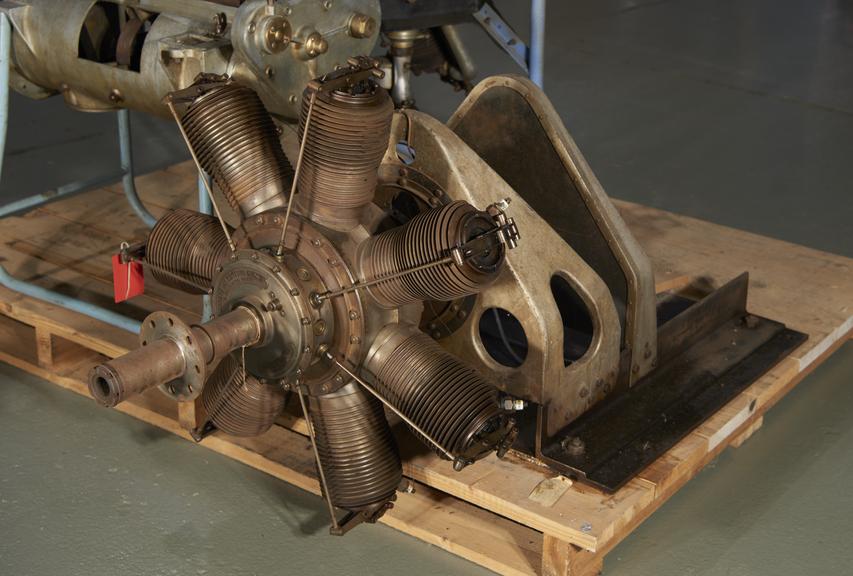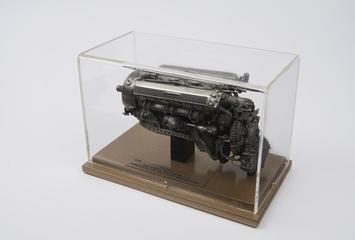
‘Gnome’ Rotary Aeroengine from a ‘Birdling’ Monoplane
- designer:
- Laurent Seguin

‘Gnome’ 50 HP 7-cylinder rotary aero engine, designed by Louis Seguin and Laurent Seguin, and made by La Société des Moteurs Gnome, France, 1908. This ‘Gnome’ 50 HP 7-cylinder rotary aero engine was removed from a ‘Birdling’ monoplane.
50 H.P. “Gnome” Rotary Engine, 1908
The “Gnome” engine is of French design and has materially assisted towards solving the problem of obtaining a reliable aeroplane engine which is capable of developing sufficient horsepower without excessive weight. In this type of engine, the crankshaft is stationary, and the cylinders and crank-chamber revolve round it.
This engine, removed from a “Birding” monoplane, has seven nickel-steel cylinders 4.3 inches diameter by 4.7 inches, stroke machined with their air-cooling ribs out of the solid. The crank-chamber is also of steel, and the cylinders are held in position by split-steel rings, which are sprung into grooves turned in the cylinders so that the cylinders cannot be withdrawn without removing the rings. Taper pins of special section, which pass through the rim of the crank-chamber, securely lock these rings in position. Piston rings of L-section brass are employed, similar in shape to the cup-leather of a hydraulic piston. The end plate, on which the airscrew is fixed when used, as in the example, as a tractor screw, carries on the inside the cams and gear wheels which operate the exhaust valve rods. Ball bearings are used to support the engine as a whole upon the stationary crankshaft, and a thrust-block is provided at the rear end of the engine.
The connecting rods all operate on a single crankpin. The big end of one of them, embracing the crank and mounted on ball bearings, is formed into a cage, the outer rings of which carry the plain bearings for the remaining six connecting rods.
The carburettor, which is stationary, is of the single jet type, and feeds the engine through the hollow crankshaft, petrol flowing thence in to the crank-chamber, from which each cylinder obtains its mixture by means of an automatic inlet-valve of the mushroom type situated in the piston-head. The valve seating also acts as a means of connection between the piston and the connecting rod.
The exhaust valves are situated in the cylinder heads, and are operated by twin balanced rocking levers actuated by long push rods connected with the cams contained in the end plate of the crank-chamber. The cams consist of seven flat steel collars with a common boss keyed on to the spindle, and are operated by an epicyclic train of wheels, the fixed wheel being on the end of the stationary crankshaft. Both the inlet and the exhaust valves are balanced against centrifugal force by means of counterweights.
An odd number of cylinders is necessary in order that the firing of the mixture in each cylinder may be carried out at equal angular intervals, and thus give an even torque, e.g. if the mixture in cylinder No. 1 was fired first, the order of firing would be 1, 3, 5, 7, 2, 4, 6, and repeat.
Ignition is effected by a Bosch high-tension magneto, mounted on stationary bracket in an inverted position, and driven by gearing. The distribution of the electric current to the sparking plugs is affected by a revolving commutator plate and a stationary brush. Firing of the change occurs just before the cylinder concerned reaches its highest position, the piston then being at the top of its stroke. Bare brass wires are employed as connections between the sparking plugs and the commutator.
Lubrication is provided for by a reciprocating-pump driven in a similar manner to the magneto, and mounted on the same plate. Castor oil only is used, and is injected into the hollow crankshaft through sight-feed fittings, and from thence to each cylinder.
When running at the normal speed of 1200 r.p.m., the engine develops 50 b.h.p. The weight per h.p. lb. is approximately 3.44.lb.
Details
- Category:
- Aircraft Propulsion
- Object Number:
- 1913-446/1
- Materials:
- asbestos and steel (metal)
- Measurements:
-
overall: 930 mm x 960 mm x 1600 mm,
- type:
- engines
- credit:
- Lady Eliott of Stobs



